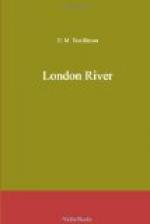The houseflag of Messrs. R. and H. Green, in any reference to the ships of Blackwall, should have been mentioned first. There is a sense in which it is right to say that the founder of that firm, at a time when American craft like the Boston clippers of Donald McKay were in a fair way to leave the Red Ensign far astern, declared that Blackwall had to beat those American flyers, and did it. But that was long before the eighties, and when steam was still ridiculed by those who could not see it equalling clippers that had logged fourteen knots, or made a day’s run of over three hundred miles. Yet some of Green’s ships came down to the end of the era, like the Highflyer and the Melbourne. The latter was renamed the Macquarie, and was one of the last of the clippers to come home to Poplar, and for that reason, and because of her noble proportions, her picture is kept, as a reminder, by many who wish to think of ships and the sea as they were. It is likely that most who live in Poplar now, and see next to its railway station the curious statue of a man and a dog, wonder who on earth Richard Green, Esq., used to be; though there are a few oldsters left still who remember Blackwall when its shipwrights, riggers, sailmakers, and caulkers were men of renown and substance, and who can recall, not only Richard Green, but that dog of his, for it knew the road to the dock probably better than most of those who use it today. Poplar was the nursery of the Clyde. The flags which Poplar knew well would puzzle London now—Devitt and Moore’s, Money Wigram’s, Duthie’s, Willis’s, Carmichael’s, Duncan Dunbar’s, Scrutton’s, and Elder’s. But when lately our merchant seamen surprised us with a mastery of their craft and a fortitude which most of us had forgotten were ever ours, what those flags represented, a regard for a tradition as ancient and as rigorous as that of any royal port, was beneath it all.
But if it were asked what was this tradition, it would not be easy to say. Its authority is voiceless, but it is understood. Then what is it one knows of it? I remember, on a day just before the War, the flood beginning to move the shipping of the Pool. Eastward the black cliffs lowered till they sank under the white tower of Limehouse Church; and the church, looking to the sunset, seemed baseless, shining with a lunar radiance. Upriver, the small craft were uncertain, moving like phantoms over a pit of bottomless fire. But downstream every ship was as salient as though lighted with the rays of a great lantern. And there in that light was a laden barque, outward bound, waiting at the buoys. She headed downstream. Her row of white ports diminished along the length of her green hull. The lines of her bulwarks, her sheer, fell to her waist, then airily rose again, came up and round to merge in one fine line at the jibboom. The lines sweeping down and airily rising again were light as the swoop of a swallow. The symmetry of her laden hull set in a plane of dancing sun-points, and her soaring amber masts, cross-sparred, caught in a mesh of delicate cordage, and shining till they almost vanished where they rose above the buildings and stood against the sky, made her seem as noble and haughty as a burst of great music. One of ours, that ship. Part of our parish.




